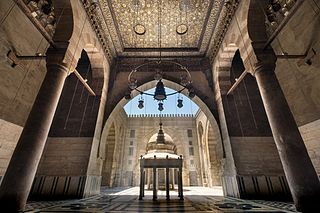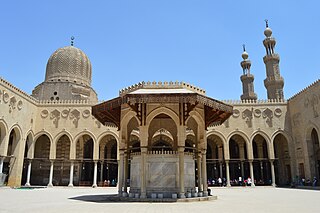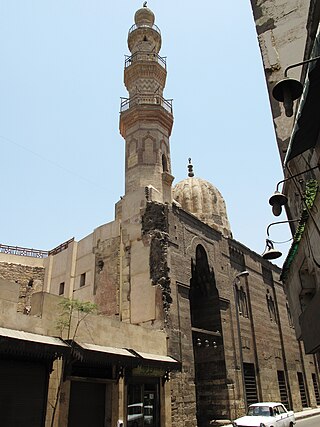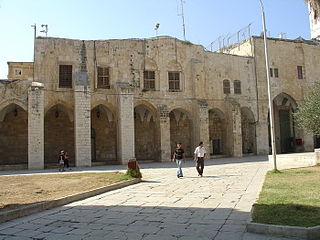The Madrasa of Jamal al-Din
One of Jamal al-Din's biggest contributions to the Cairo landscape was his role in designing the Madrasa of Jamal al-Din in 1407, an elaborate cruciform madrasa dedicated to all four schools of law. [2] It is located in the al-jamaliyah district of Cairo Egypt, a district whose name comes from him and the architectural influence he had. The design and decoration of this madrasa was quite ornate, as Jamal al-Din took some of the materials from the deteriorating madrasa of al-Ashraf. This was a practice often utilized by Mamluk's throughout history, perhaps as a cost saving mechanism. [3] The madrasa is in the four-iwan layout, meaning it contains four different hallways, and each hallway faced an open courtyard in the center. It contains all of the features generally found in a religious building, including a bent entryway, a tomb, and an ablution area. [2] However, the building of this madrasa was not without controversy, as it is alleged that Jamal al-Din over-invested materials and capital in order to enhance it and model it after a palace with the intention of retiring in it. He eventually faced public disgrace, and al-Din Faraj executed Jamal al-Din and annulled his transactions that went into making the madrasa in 1411. [3] However, he refrained from tearing it down, and it still stands to this day. The madrasa received earthquake damage in 1992 to go along with centuries of weather and general wear, but it was restored with the help of the Ministry of Culture. [2]
He also founded the Maḥmūdīyah Library in Cairo in 1394-1395 CE, making it the largest madrasa library in Mamluk Egypt and Syria. [4]

Al-Malik Az-Zahir Sayf ad-Din Barquq was the first Sultan of the Circassian Mamluk Burji dynasty of Egypt ruling from 1382 to 1389 and 1390 to 1399. Born to a Christian father in Circassia, Barquq was enslaved and later arrived in Egypt. He deposed sultan al-Salih Hajji to claim the throne for himself. Once in power, he placed many of his family members in positions of power. Rebelling governors in 1389 restored Hajji to the throne but Barquq was able to reclaim the throne shortly after and ruled until his death in 1399 and was succeeded by his son. The name Barquq is of Circassian origin and is his birth name.

The Zahiriyya Library, also known as the Madrasa al-Zahiriyya, is an Islamic library, madrasa, and mausoleum in Damascus, Syria. It was established in 1277, taking its name from the Mamluk sultan Baybars al-Zahir, who is buried in this place.

The Qalawun complex is a massive pious complex in Cairo, Egypt, built by Sultan al-Mansur Qalawun from 1284 to 1285. It is located at Bayn al-Qasrayn on al-Mu'izz street and like many other pious complexes includes a hospital (bimaristan), a madrasa and mausoleum. Despite controversy surrounding its construction, this building is widely regarded as one of the major monuments of Islamic Cairo and of Mamluk architecture, notable for the size and scope of its contributions to legal scholarship and charitable operations as well as for the richness of its architecture.

The Mosque of Sultan al-Mu'ayyad is a Mosque in Cairo, Egypt next to Bab Zuwayla built under the rule of sultan Al-Mu'ayyad Sayf ad-Din Shaykh from whom it takes its name, "Al-Mu'ayyad", meaning The Supporter in Arabic language. Construction began in 1415 and the mosque was completed in 1421. The complex included a Friday mosque and a madrasa for four madhhabs. It replaced a prison which originally stood next to Bab Zuwayla.

Fountain of Qayt Bay or Sabil Qaitbay is a domed public fountain (sabil) on the western esplanade of the al-Haram al-Sharif in Jerusalem, near the Madrasa al-Ashrafiyya. Built in the 15th century by the Mamluks of Egypt, it was completed in the reign of Sultan Qaytbay, after whom it is named. It is also colloquially known as the Fountain of Hamidiye due to Sultan Abdul Hamid II’s restoration. It has been considered, "after the Dome of the Rock, the most beautiful edifice in the Haram".

The cruciform Madrasah of the Amir Sarghatmish, built in 1356, lies to the northeast of the Mosque of Ibn Tulun, in Islamic Cairo. The building's school, mosque, and mausoleum can be seen from Ibn Tulun's spiral minaret, while its entrance is on Saliba Street. This structure includes a madrasa, mosque, and mausoleum. The madrasa is also referred to as the Mosque of Amir al-Sayf Sarghatmish.

The Mosque and Khanqah of Shaykhu is an Islamic complex in Cairo built by the Grand Emir Sayf al-Din Shaykhu al-Nasiri. The mosque was built in 1349, while the khanqah was built in 1355. Shaykhu was the Grand Emir under the rule of Sultan an-Nasir Hasan.

The Ancient City of Aleppo is the historic city centre of Aleppo, Syria. Prior to the Syrian Civil War, many districts of the ancient city remained essentially unchanged since they were initially constructed between the 11th and 16th centuries. Being subjected to constant invasions and political instability, the inhabitants of the city were forced to build economically independent cell-like quarters and districts, most of which were delineated along ethnic and religious lines. These urban subdistricts, along with the ancient walled city that they surround, comprise an approximate area of 350 hectares and are home to more than 120,000 residents.

Mamluk architecture was the architectural style that developed under the Mamluk Sultanate (1250–1517), which ruled over Egypt, the Levant, and the Hijaz from their capital, Cairo. Despite their often tumultuous internal politics, the Mamluk sultans were prolific patrons of architecture and contributed enormously to the fabric of historic Cairo. The Mamluk period, particularly in the 14th century, oversaw the peak of Cairo's power and prosperity. Their architecture also appears in cities such as Damascus, Jerusalem, Aleppo, Tripoli, and Medina.
Sayf ad-Din Sirghitmish ibn Abdullah an-Nasiri, better known as Sirghitmish was a prominent Mamluk emir during the reign of Sultan an-Nasir Hasan. By 1357, Sirgitmish was the most powerful emir in an-Nasir Hasan's court. That year, he had the Madrasa of Sirghitmish built in Cairo. In 1358, the sultan's suspicions of a coup plot by Sirghitmish led to his imprisonment and subsequent death.

Amir Jamal al-Din al-Ustadar Mosque is a historic mosque in the city of Cairo. It is located inside Islamic Cairo, facing the Al-Tambakshiya Street to the north and the Habas al-Rahb Street to the southeast.

The Khanqah of Faraj ibn Barquq is a religious Islamic funerary complex built by the Mamluk Sultan Faraj ibn Barquq from 1400 to 1411 CE. It is located in Cairo, Egypt, in the Northern Cemetery which is a part of Cairo's historic necropolis districts. It is considered one of the most accomplished works of Mamluk architecture and one of the major monuments of Cairo's Northern Cemetery district.

The Madrasaal-Ashrafiyya is an Islamic madrasa structure built in 1480–1482 by the Mamluk sultan al-Ashraf Qaytbay on the western side of the Haram al-Sharif in Jerusalem. Although only a part of the original structure still stands today, it is a notable example of royal Mamluk architecture in Jerusalem.

The Khanqah and Mausoleum of Sultan Barsbay or Complex of Sultan Barsbay is an Islamic funerary complex built by Sultan al-Ashraf Barsbay in 1432 CE in the historic Northern Cemetery of Cairo, Egypt. In addition to its overall layout and decoration, it is notable for the first stone domes in Cairo to be carved with geometric star patterns.

The Madrasa of Umm al-Sultan Sha'ban is a Mamluk-era complex located in the Al-Darb al-Ahmar area of Islamic Cairo in Egypt. It was founded or built in 1368-69 CE on the order of Sultan al-Ashraf Sha'ban in honour of his mother, Khawand Baraka. It is located outside Bab Zuweila along al-Tabbana street, and is adjoined to the north by the Bayt al-Razzaz palace. The complex is made up of a college (madrasa), mausoleum, water trough (hawd), and a primary school (maktab).

The Maristan of al-Mu'ayyad or Bimaristan al-Mu'ayyadi is a bimaristan constructed by the Mamluk sultan al-Mu'ayyad Sheikh between 1418 and 1420. It is located on the southern edge of the Darb al-Ahmar district in Cairo, Egypt, near the Citadel of Cairo and the former Bab al-Wazir gate. It did not serve its function as hospital very long and stood ruined for many years. Its facade and main walls have survived, and have been recently restored.

Sayf al-Din Jaqmaq was the Mamluk sultan of Egypt from 9 September 1438 to 1 February 1453.

The at-Tankiziyya is a historic building in Jerusalem that included a madrasa. It is part of the west wall of the al-Aqsa Compound. It is also known as the Maḥkama building.

Al-Qadi al-Amir Saad al-Din Ibrahim bin Abd al-Razzaq bin Ghurab al-Qibti al-Iskandarani al-Masry, Saad al-Din bin Alam al-Din bin Shams al-Din, commonly known as Saad al-Din bin Ghurab, was Amir al-Umara in the Mamluk Sultanate of Egypt and its de facto ruler starting from 1399, following the death of Sultan al-Zahir Barquq. Ibn Ghurab was able to combine the roles of Arbab al-Aqlam and Arbab al-Syouf. He played a significant role in mitigating the effects of the famine that struck Egypt during the era of Sultan an-Nasir Faraj by distributing bread, clothing and food, and spending money on charitable activities.
The Maḥmūdīyah Library, also known as the Maḥmūdīyah Madrasa Library, was established in Cairo, Egypt, in 1394-1395 CE. It was the largest madrasa library in Mamluk Sultanate and Syria, attracting prominent scholars with its rare and impressive collection of books.


















